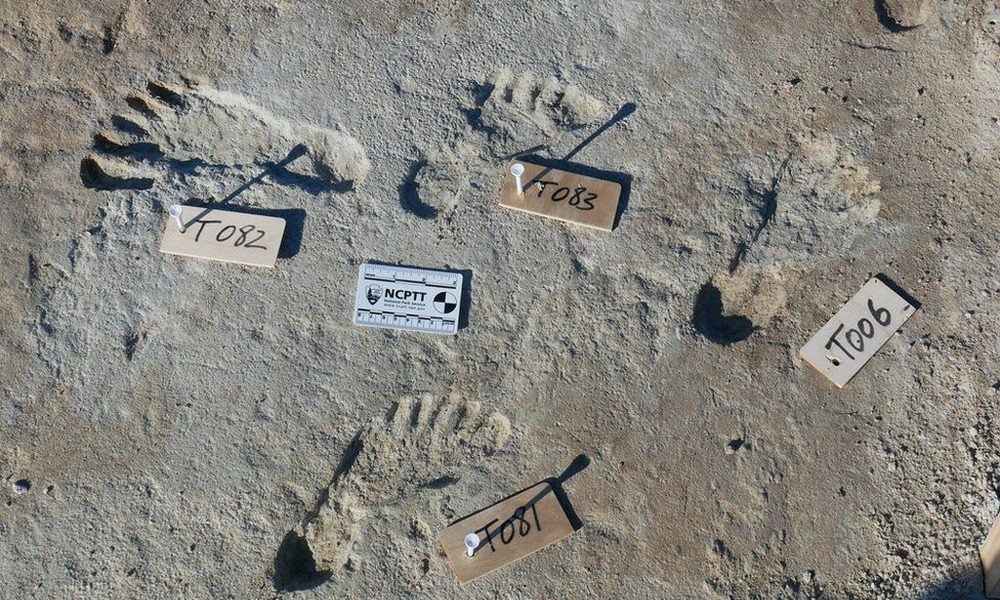
Footprints in New Mexico Prove Humans Got to The Americas Earlier Than We Thought

For decades, controversy surrounds the question of when settlers from Asia first made their way to the Americas. According to new findings published in the journal Science, scientists think the date falls to 7,000 years earlier than was previously disclosed.
This theory has its own bunch of skeptics attached to it as they believe that North America had no human beings inhabiting it earlier than 16,000 years ago. But, challenging said opinion, human footprints dating to around 21,000 to 23,000 years old have recently been discovered by a team working in New Mexico.

Bournemouth University | The research team went all in for this amazing discovering
More on the Discovery
This new finding has the potential to transform scientific belief over when settlers first migrated to the continent. It also opens more gray areas like possible ancient populations that could have gone extinct without being heard of or entire migrations that we know nothing about.
The White Sands National Park’s Alkali Flat trail once held a shallow lake along which the soft-mud footprints were discovered. Radiocarbon dating carried out by a US Geological Survey team found layers of sediment both below and above the area where the footprints were discovered.

Bournemouth University | This lucky fact enabled researchers to gauge precise dates for when the prints were left behind
Here’s What the Team Thinks
Judging from the sizes of the prints, scientists weigh up that the strolling group consists of younger children and teenagers – and maybe the occasional adult – traveling back and forth.
While we don’t have exact answers for what this group was doing in the area, it is speculated that they might have been helping their elders in a sort of hunting tradition, which involved driving animals over a shallow cliff edge, termed as the buffalo jump, which was later observed in Native American cultures.
According to Bournemouth University professor and research co-author Dr. Sally Reynolds, these ancient people had a short period of time to process all the animals. They’d have to build fires, render the fat from the animals, etc.

Bournemouth University | The younger folk could possibly be responsible for collecting water, firewood, and other required items, thinks the research team
Here’s Why This Discovery is Important
Due to certain stone tools being found in various places in the Americas, there have been countless claims for the first human settlement. But, all of them have been disputed in one way or another because the question boils down to whether or not said tool was preserved in its original form.
Or if it had fallen from a height, such as from a cliff. However, footprints are different. They cannot be relocated. They can’t fall from a cliff. Footprints provide definite answers. And there’s no denying that an ancient human settlement existed in what we now know as the Southwest US about 21,000 to 23,000 years ago.
More in Buzz
-
`
Camilla Bowles & Prince Charles Ask People to Remember The Elderly This Holiday Season
Every year as the holiday season begins, we rush to the shopping centers and wait in long queues just to grab...
December 27, 2021 -
`
Baby Mama Olivia Munn Welcomes First Child With John Mulaney
You might think that this is wholesome news and there is nothing problematic about it – but guess again! As it...
December 23, 2021 -
`
Being A Feminist – The Dad Version
Feminism – an ideology that works to establish social, personal, economic, and political equality of humankind. In this day and age,...
December 22, 2021 -
`
Starting a Business Can Be Overwhelming–Here’s How You Can Get Over Your Fears & Start Building Your Company
Successfully building a business from the ground up, is not an achievement that all people can claim to have done. It...
December 22, 2021 -
`
Too Busy Working as a Corporate Executive to Manage Your Finances? These Are The Simple Steps You Can Take Today
Corporate executives often find themselves in an interesting predicament. After they’ve managed to put in the work to nab the high-paying...
December 21, 2021 -
`
Leonardo DiCaprio Buys a $9.9 Million Beverly Hills Mansion
Leonardo DiCaprio is no stranger in the world of Hollywood – and if you don’t know him, what have you been...
December 17, 2021 -
`
Kevin Hart Drops $7 Million on The Property Next to His Calabasas Mansion
People often say that kindness is making someone laugh, even if it’s only for a moment. Well, going by that logic,...
December 8, 2021 -
`
Two Decades Worth Of Jennifer Aniston’s Real Estate Grabs – Take A Look!
Jennifer Aniston! Who doesn’t know and love the superstar who breathed life into iconic characters like Rachel Green, Rosie Dickinson, Rose...
December 7, 2021 -
`
Let’s Hear it For The Long-Awaited Film, House of Gucci
Have you watched the House of Gucci yet? The movie has got to be one of the most anticipated ones of 2021 –...
December 1, 2021















You must be logged in to post a comment Login